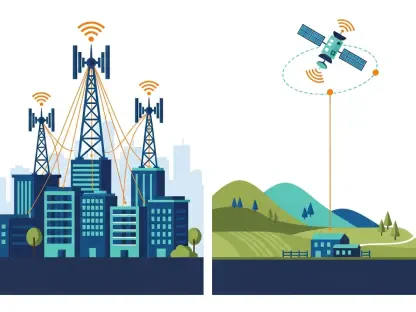The European Open RAN market is buzzing with activity, heralding a new phase in 5G networks. As telecom operators push for innovative solutions, Open RAN is at the forefront of this transformation. This comprehensive analysis delves into the various facets, exploring growth trends, market dynamics, challenges, and opportunities.
The Rising Importance of Open RAN
Understanding Open RAN
Open RAN’s flexible and interoperable network solutions are reshaping Europe’s telecommunications landscape. Its ability to integrate hardware and software from multiple vendors presents a game-changer for operators. Unlike traditional RAN architectures that rely on proprietary systems, Open RAN allows telecom operators to choose components from different suppliers, fostering a competitive environment and reducing dependence on single-vendor solutions. This flexibility is crucial for managing network infrastructure cost-effectively, particularly in an era marked by rapid technological advancements and expanding connectivity demands.
The concept of Open RAN has gained momentum due to the noticeable benefits it offers, including reduced operational expenses and improved network performance. By leveraging software-defined networking and virtualization technologies, Open RAN enables more efficient use of resources, enhancing overall network adaptability. Furthermore, the technology promotes innovation through collaborative frameworks, where industry players collectively work towards standardized solutions. In essence, Open RAN epitomizes the shift towards agile and resilient network architectures that can accommodate emerging requirements with ease.
Growth Drivers
Several factors are propelling Open RAN forward. The increased demand for network flexibility and the accelerated rollout of 5G networks are among the key drivers. Telecom operators are increasingly seeking interoperable solutions to integrate hardware and software from multiple vendors, reducing reliance on proprietary systems. This demand is driving a noticeable increase in Open RAN deployments. As Europe moves towards ubiquitous 5G coverage, the appeal of Open RAN’s flexible architecture continues to grow, attracting significant investments and fostering widespread adoption.
The European Union’s ambitious Digital Decade initiative aims to achieve full 5G coverage by 2030, further bolstering the rise of Open RAN technologies. The prospect of harnessing Open RAN to facilitate seamless integration and optimized deployments has galvanized stakeholders across the continent. Successful implementations have demonstrated the potential for reducing network deployment costs by 25%, underscoring the technology’s efficacy in addressing budget constraints while meeting performance benchmarks. With such tangible benefits, the momentum behind Open RAN continues to accelerate, setting the stage for extensive advancements in Europe’s telecommunications landscape.
5G Adoption
Rapid adoption of 5G networks is setting Open RAN on a growth trajectory. With companies like Nokia and Ericsson creating compatible solutions, Open RAN is seeing higher satisfaction rates among users. The need for high-speed connectivity and low-latency applications is a primary reason for the widespread adoption of 5G, creating fertile ground for Open RAN proliferation. The role of leading telecommunication firms in championing Open RAN-compatible devices and platforms has been instrumental in driving market growth, ensuring that next-gen network capabilities are seamlessly integrated into existing infrastructures.
Moreover, the deployment of 5G networks promotes a robust environment for innovative applications and services. Technologies such as IoT (Internet of Things), augmented reality (AR), and virtual reality (VR) are becoming increasingly viable, thanks to the enhanced performance metrics facilitated by Open RAN solutions. The transition to 5G signifies not just an upgrade in network speeds but a transformational leap toward a digital ecosystem that can support complex and data-intensive applications. Consequently, the alignment of Open RAN with 5G goals is a critical factor in securing its place as a cornerstone of Europe’s future telecommunications infrastructure.
Challenges to Market Growth
Integration Costs
Despite its benefits, Open RAN faces hurdles. High initial costs and complexities in integrating multi-vendor systems challenge telecom operators. The process involves significant investment in equipment, software, and human resources to ensure seamless interoperability between diverse components. Telecom operators are tasked with navigating these integration challenges to maintain uninterrupted service delivery and performance quality. The upfront capital required for deploying Open RAN infrastructures can be substantial, often dissuading smaller operators from entering the market or expanding their existing systems.
Additionally, the technical complexities associated with Open RAN entail a steep learning curve. Professionals must be proficient in managing heterogeneous systems, troubleshooting compatibility issues, and optimizing network operations. The intricacies of combining various vendor solutions necessitate robust frameworks for monitoring, administration, and regular maintenance. The challenges inherent in integration do not merely impact the financial aspect but extend to operational dynamics, thereby requiring strategic investments in training and development to build a capable workforce proficient in Open RAN technologies.
Security Concerns
Security is a significant concern. The multi-vendor architecture increases vulnerabilities, making operators cautious in adopting these solutions fully. Open RAN’s reliance on interoperable components from various sources necessitates stringent security protocols to guard against cyber threats. The decentralized nature of the architecture can create potential entry points for malicious actors looking to exploit system weaknesses. Operators must implement comprehensive cybersecurity measures to protect sensitive data, ensuring network integrity and reliability. Security concerns have led to hesitance among some telecom entities, wary of the risks involved in transitioning to Open RAN infrastructures.
Moreover, ensuring security in an Open RAN environment demands continuous vigilance and adaptability. Cybersecurity frameworks must evolve in response to emerging threats, requiring consistent and dynamic strategies to safeguard network operations. This includes employing advanced encryption techniques, conducting regular vulnerability assessments, and fostering secure collaboration among vendors. The need for proactive security measures is paramount in safeguarding the integrity of Open RAN systems and maintaining user trust. The balance between embracing innovation and mitigating risks remains a critical factor for telecom operators navigating this complex landscape.
Leveraging Opportunities
Expansion of Private 5G Networks
Open RAN offers vast potential in private 5G networks, especially for industries like manufacturing, healthcare, and logistics. Private 5G networks are dedicated systems tailored to specific organizational needs, providing enhanced security, reliability, and performance. Open RAN’s customizable solutions enable enterprises to configure networks according to their unique operational requirements, resulting in optimized productivity and efficiency. In manufacturing, for instance, Open RAN facilitates real-time monitoring and automation processes, reducing downtime and streamlining production workflows.
Healthcare facilities benefit from Open RAN’s robust capabilities by implementing advanced telemedicine solutions and ensuring uninterrupted communication between medical professionals and patients. Furthermore, logistics companies leverage Open RAN to enhance tracking systems, streamline supply chain operations, and improve delivery accuracy. Private 5G networks integrated with Open RAN technology empower industries to innovate and adapt rapidly to changing market demands. The expansion of these networks underscores the transformative impact of Open RAN beyond traditional telecom sectors, fostering a versatile digital ecosystem.
Public-Private Partnerships
Collaborative efforts between governments and private entities boost Open RAN adoption. These partnerships offer substantial benefits, including financial support, regulatory frameworks, and research initiatives aimed at accelerating technological advancements. Governments are increasingly recognizing the strategic importance of Open RAN in driving national digital agendas and enhancing connectivity. Public-private partnerships facilitate the necessary infrastructure investments and policy developments to support widespread integration and deployment of Open RAN systems.
Such collaborative programs provide a platform for sharing expertise, resources, and innovation. Market players gain access to government subsidies and grants that reduce financial barriers, enabling them to invest more extensively in Open RAN technologies. Furthermore, these partnerships foster an environment of collective growth and development where industry stakeholders can pool their knowledge and capabilities to address common challenges. The synergy between the public and private sectors plays a pivotal role in shaping the future of Open RAN in Europe, ensuring robust support and momentum for continued market expansion.
Emerging Trends
Technological Advancements
Investments in AI-driven analytics, cloud-native architectures, and virtualized network infrastructure are vital trends to watch. These technological advancements are pivotal in facilitating Open RAN’s integration into existing networks and enhancing overall performance. AI-driven analytics provide crucial insights into network operations, enabling predictive maintenance, real-time optimization, and adaptive strategies to manage network traffic efficiently. Transitioning to cloud-native architectures ensures scalability and flexibility, making Open RAN systems resilient to varying demands and facilitating rapid deployments across diverse environments.
Virtualized network infrastructure revolutionizes how network resources are managed and allocated. By decoupling hardware from software, virtualization enables dynamic resource provisioning, enhancing efficiency and reducing operational costs. These advancements collectively contribute to a robust foundation for Open RAN technologies, ensuring that networks are equipped to handle the complexities of modern telecommunications. The convergence of AI, cloud-native frameworks, and virtualization technologies represents a significant shift towards intelligent, adaptive, and resilient network infrastructures vital for addressing future connectivity requirements.
Government Initiatives
Government support plays a crucial role. Initiatives and subsidies enhance research capabilities, reducing financial barriers for market adoption. European governments have launched multiple programs aimed at fostering the development and deployment of Open RAN technologies, recognizing their strategic importance in achieving digital transformation goals. These initiatives include funding for research and development, tax incentives for companies investing in Open RAN infrastructures, and regulatory frameworks that promote interoperability and competition within the market.
Such governmental support extends to facilitating industry collaboration, where public sector entities work alongside private telecom operators to pilot and refine Open RAN solutions. The emphasis on research and development ensures continuous innovation, addressing emerging challenges and capitalizing on new opportunities. The alignment of national policies with technological advancements underscores the importance of a concerted effort in driving the Open RAN agenda forward. Governments play an instrumental role in shaping a conducive environment for Open RAN proliferation, ensuring sustainable growth and widespread adoption across the United States.
Market Segments
Component Analysis
The hardware segment leads in market share due to advanced 5G network infrastructure. Open RAN hardware components such as antennas, base stations, and radio units form the backbone of high-speed connectivity solutions. These elements are critical for ensuring robust network performance and coverage, particularly in urban areas with dense populations. The demand for reliable and scalable hardware solutions drives significant investments and innovations in this segment, ensuring that network infrastructures are equipped to meet evolving connectivity needs.
Meanwhile, the software segment is registering significant growth rates, propelled by the popularity of virtualization and cloud computing. Open RAN software includes essential elements such as network management systems, orchestration platforms, and analytics tools. These components are vital for optimizing network operations, facilitating seamless integration, and enhancing resource allocation efficiencies. The software segment’s robust growth reflects the market’s shift towards intelligent and adaptive network solutions, ensuring that Open RAN systems can dynamically respond to changing demands and performance requirements.
Unit Deployment
Radio units continue to dominate, driven by their pivotal role in 5G. These units are critical for transmitting and receiving signals, forming the backbone of 5G deployments. With high-speed connectivity and low-latency requirements, radio units are indispensable for ensuring seamless data transmission across extensive networks. The dominance of radio units in the Open RAN market is underscored by significant investments in developing advanced technologies that enhance signal strength, coverage, and reliability, particularly in densely populated urban environments.
Distributed units are also gaining traction owing to advancements in edge computing. These units decentralize network resources, bringing computing power closer to end-users and devices. This decentralization facilitates real-time data processing and analytics, reducing latency and enhancing user experience. The integration of distributed units with Open RAN architectures represents a significant shift towards edge computing, enabling faster and more efficient connectivity solutions. The growing adoption of distributed units reflects the market’s emphasis on optimizing network performance through innovative and adaptive technologies.
Cloud Solutions
Private cloud deployments are preferred for their security and dedicated solutions. Industries such as healthcare and finance prioritize private clouds for their ability to ensure data confidentiality, reliability, and compliance with stringent regulatory standards. Private cloud environments offer enhanced control over network operations, facilitating tailored solutions that meet specific organizational needs. These secure and dedicated solutions are crucial for sectors where data sensitivity and operational integrity are paramount, driving substantial demand for private cloud deployments integrated with Open RAN technologies.
Hybrid cloud deployments grow rapidly due to their flexibility. Combining the benefits of public and private clouds, hybrid deployments offer scalable and cost-effective solutions that can adapt to varying demands and performance requirements. Hybrid clouds enable seamless integration of diverse resources, facilitating efficient management and optimization of network operations. The flexibility of hybrid cloud solutions makes them appealing to a broader spectrum of industries and applications, driving significant growth in this segment. The emphasis on hybrid cloud deployments reflects the market’s pursuit of adaptable and resilient network solutions that can navigate complex and dynamic connectivity landscapes.
Network Types
4G networks enjoy widespread adoption, but the 5G segment is experiencing the fastest growth due to rising demand for ultra-low latency applications. The established presence of 4G networks across Europe provides a solid foundation for connectivity, with extensive infrastructure and coverage ensuring reliable performance. However, the shift towards 5G represents a transformative leap in network capabilities, driven by the need for high-speed data transmission, real-time applications, and enhanced user experiences. The rapid expansion of 5G networks underscores the market’s drive toward next-generation connectivity solutions that can support emerging technological demands and innovations.
The growth trajectory of 5G networks is marked by significant investments in infrastructure development, technology integration, and strategic partnerships. The deployment of 5G networks facilitates a wide array of applications, including IoT, smart cities, autonomous vehicles, and enhanced mobile experiences. The emphasis on ultra-low latency and high device connectivity positions 5G as a cornerstone of the digital future, driving profound changes in how connectivity is perceived and utilized. The ongoing expansion of 5G networks signals a pivotal shift towards robust and adaptive connectivity solutions integral to Europe’s technological evolution.
Frequency Bands
Sub-6 GHz frequencies are dominant and essential for urban deployments. These bands balance coverage and capacity, making them ideal for providing wide-area connectivity in densely populated regions. Sub-6 GHz frequencies ensure reliable signal transmission and reception, facilitating seamless connectivity across extensive urban landscapes. The dominance of these frequencies reflects their suitability for meeting diverse connectivity needs, particularly in scenarios where robust coverage and performance are paramount.
MmWave frequencies are anticipated to grow due to the need for high-speed connectivity in dense areas. These frequencies offer significant bandwidth, capable of supporting ultra-fast data transmission rates essential for applications requiring high-speed connectivity. The growth of mmWave frequencies aligns with the market’s pursuit of enhanced performance metrics, driving innovations and investments in technologies that leverage these high-capacity bands. The emphasis on mmWave frequencies underscores the evolving demands for connectivity solutions that can address the complexities of dense urban environments, ensuring that network infrastructures are equipped to support modern data-intensive applications.
Country-Specific Insights
Germany
Germany’s Economic Landscape
Given its robust economy, Germany is often seen as the powerhouse of Europe. The country excels in various industrial sectors, including automotive, engineering, chemicals, and renewable energy. Its economic strength allows it to play a significant role in the European Union and international trade.
Germany’s Cultural Heritage
Germany boasts a rich cultural heritage that spans literature, music, philosophy, and art. Renowned composers such as Ludwig van Beethoven and Johann Sebastian Bach, along with influential philosophers like Immanuel Kant, highlight the country’s contribution to the cultural and intellectual world.
Tourist Attractions in Germany
Tourists flock to Germany for its diverse attractions. The historic Brandenburg Gate in Berlin, the fairy-tale Neuschwanstein Castle in Bavaria, and the picturesque Rhine Valley are just a few examples. Germany’s blend of modernity and tradition offers a unique experience to visitors from around the globe.
Germany leads the market with a robust telecom infrastructure and proactive government initiatives. The country’s strong digital agenda and investment in telecommunications provide a solid foundation for the widespread adoption of Open RAN technologies. Germany’s commitment to enhancing connectivity and fostering innovation is evident in its strategic policies and substantial support for research and development initiatives. The proactive stance of the German government in promoting Open RAN ensures that market players can navigate the complexities of integration and deployment seamlessly, driving significant growth and advancements in this segment.
Germany’s telecom operators benefit from well-established infrastructure, facilitating the rollout of advanced network solutions. The collaborative environment fostered by government initiatives encourages industry stakeholders to innovate and invest in Open RAN technologies, ensuring that the market remains competitive and dynamic. The emphasis on modernizing telecommunications infrastructure aligns with Germany’s broader goals of achieving comprehensive digital transformation, positioning the country as a leader in driving Open RAN adoption and integration.
United Kingdom
Driven by strong digital transformation programs, the UK holds a significant market share. The country’s focus on enhancing connectivity and embracing technological advancements is reflected in government policies that support Open RAN deployment. The UK’s strategic initiatives aim to facilitate seamless integration, foster innovation, and ensure robust performance metrics across telecommunications networks. The proactive support from government entities enables telecom operators to navigate the initial challenges of implementing Open RAN technologies, driving substantial market growth and adoption.
The UK’s digital transformation agenda emphasizes the importance of modernizing infrastructure and ensuring widespread connectivity. The alignment of national policies with industry goals fosters a conducive environment for Open RAN proliferation. Telecom operators benefit from government grants, subsidies, and research funding that reduce financial barriers and encourage extensive investments in innovative network solutions. The collaborative framework between public and private sectors underscores the UK’s commitment to driving the future of telecommunications through strategic and comprehensive support for Open RAN technologies.
France
With extensive government support, France remains a key player in Open RAN market expansion. France’s commitment to fostering innovation and enhancing connectivity is evident in its robust digital agenda and strategic policies that promote the adoption and integration of Open RAN technologies. The proactive approach of the French government in supporting research and development initiatives ensures a competitive and dynamic market landscape. Telecom operators benefit from substantial grants, subsidies, and regulatory frameworks that facilitate seamless integration and deployment of Open RAN solutions.
France’s emphasis on modernizing telecommunications infrastructure aligns with its broader goals of achieving comprehensive digital transformation. The collaborative environment encourages industry stakeholders to innovate and invest in advanced network solutions, ensuring that the market remains competitive and dynamic. Strategic support from government entities enables telecom operators to address initial challenges of implementing Open RAN technologies, driving significant market growth and advancements. The focus on enhancing connectivity and fostering innovation positions France as a key player in driving the future of telecommunications through strategic and comprehensive support for Open RAN technologies.
Competitive Landscape
Key Market Players
Major contributors including Nokia, Ericsson, and Samsung Electronics are enhancing interoperability, reducing costs, and customizing solutions for various industries. These companies play a crucial role in driving innovation and shaping the future of Open RAN technologies. Nokia’s cloud-native platform and Ericsson’s hybrid cloud partnerships exemplify the strategic moves that major players undertake to advance Open RAN solutions. By focusing on interoperability and customized solutions, these companies ensure that Open RAN technologies can adapt to diverse industry requirements, facilitating seamless integration and optimized performance.
The contributions of Samsung Electronics through its AI-driven analytics platform highlight the emphasis on leveraging advanced technologies to enhance network performance. By investing in innovative solutions and strategic partnerships, major players drive the competitive dynamics of the Open RAN market, ensuring robust growth and extensive adoption. The focus on reducing costs and enhancing customization underscores the importance of tailored solutions that address specific organizational needs, positioning major players as leaders in driving the future of telecommunications through Open RAN technologies.
Strategic Moves
Companies focus on multi-vendor integration, expanding distribution networks, and addressing regulatory pressures. The strategic emphasis on multi-vendor integration ensures that Open RAN solutions can seamlessly accommodate diverse components, fostering a competitive environment and reducing reliance on single-vendor systems. Expanding distribution networks facilitates widespread adoption, ensuring that Open RAN technologies can reach a broader spectrum of industries and applications. Addressing regulatory pressures is crucial for ensuring compliance and safeguarding network integrity, driving strategic investments in security and interoperability frameworks.
Smaller firms leverage innovative technologies to compete effectively. By focusing on niche solutions and addressing specific market needs, these companies carve out unique positions within the competitive landscape, contributing to the dynamic evolution of the Open RAN market. The emphasis on innovative technologies and strategic moves drives growth and ensures that the competitive dynamics remain robust and adaptive. The collaborative efforts between major players and smaller firms foster a comprehensive environment for innovation and development, ensuring that Open RAN technologies can continuously evolve to meet emerging demands.
Recent Developments
The European Open RAN market is vibrant with activity, signaling a new era for 5G networks. Telecom operators are striving for innovative solutions, placing Open RAN at the forefront of this technological evolution. This in-depth analysis examines the multiple dimensions of Open RAN, investigating growth trends, market dynamics, and the challenges and opportunities that come with this advancement.
Open RAN, or Open Radio Access Network, is an approach to building cellular networks, particularly 5G, with open and standardized interfaces. It allows different vendors’ equipment to interoperate smoothly, breaking the traditional reliance on a single supplier. This shift brings a competitive edge, as it opens the market to new players and fosters innovation, while potentially reducing costs.
Growth trends in the Open RAN market indicate a robust expansion, driven by the demand for more flexible and efficient network solutions. Europe, with its multitude of telecom giants, is at the center of this movement, and these companies are increasingly adopting Open RAN to enhance their 5G offerings and remain competitive globally.
However, despite its potential, Open RAN faces several challenges. Concerns about network security, integration complexities, and the need for significant investment in new technology are notable hurdles. Yet, the opportunities presented by Open RAN are immense. It promises increased competition, lower costs, and the flexibility needed to keep pace with rapid technological advances.
In conclusion, the European Open RAN market is a hotbed of innovation and growth, poised to redefine the landscape of 5G networks amidst both challenges and significant opportunities.









